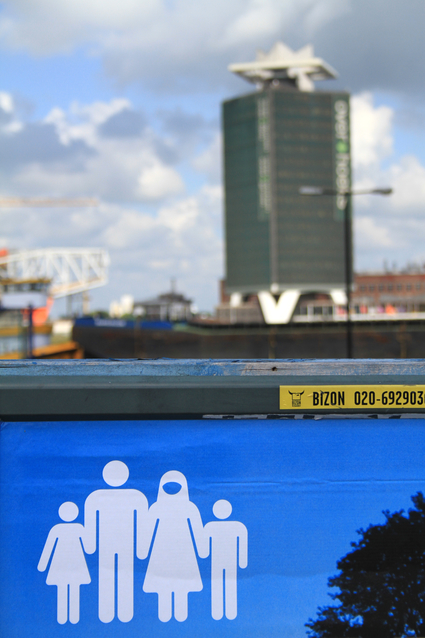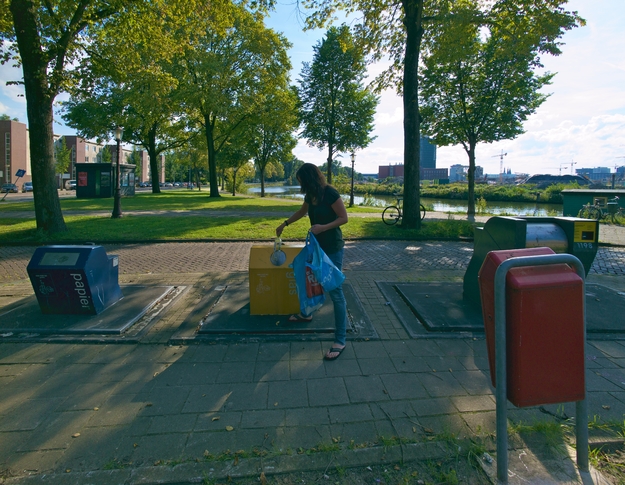Why does our guide deal with Noord? Because Noord shares more characteristics with The Netherlands as a whole, than it does with Amsterdam, our capital on the other side of ‘t IJ. Except for the dunes, Noord houses everything The Netherlands does. Several of the country's most essential components are more visible in Noord then in any other place in The Netherlands. It's like a theme park; yet everything is real.
Why Arabic? Because a lot of the inhabitants of Noord can trace their roots back to North-African and Middle-Eastern cultures. But even more so because Noord is the ideal destination for people from these areas. Noord is spacious and green, and there's a lot of water. It's quiet and clean. Therefore, it's a good place for a short and relaxing summer visit to Europe. In this guide you'll encounter a lot of nature pictures; all made in and around Noord during the summer months. Almost all of this nature is publicly accessible and, above all, smells good.
The only things Noord doesn't have, are luxury shops. It is not easy to spend a lot of money in Noord. If that's your reason to go on holiday, you should have probably gone to Switzerland.
Noord is, even more so than the rest of Western Europe, a planned city. Land has been carefully separated from water, making use of ditches, canals, dikes and pumping stations. Land has been reclaimed, and turned into polder area. These days, electronic pumping stations are used instead of windmills, creating a more aesthetically pleasing experience.
All the land in and around Noord has been designed and made by men. The so-called 'nature' outside of the ring-road and on the water, is completely programmed, managed and maintained by the government. The Dutch are so pleased with this situation, that they've decided to let the copious amounts of waterbirds swim, instead of eat them. Experience how dramatically the city bleeds into nature on the northeastern side - it's a must. You undergo an almost cinematographic experience as you ride out into the water and the fields, and the environmental sounds around you change. Best experienced on a rental bike.
View of Overhoeks - View of Overhoeks in Amsterdam Noord. Made by Noord participant Mahmoud Hamdy.

Thrilling and never-ending: you can easily experience the whole of The Netherlands while cycling through the urban area of Amsterdam-Noord. Old monumental centers are juxtaposed with garden cities and social housing projects developed during the twentieth century. In between, you'll cross ship yards, chemical plants and industrial heritage areas that have recently been transformed into offices for hip artists and media professionals.
Like the rest of The Netherlands, Noord is ethnically and socially a very diverse place. The rich and the powerful live in monumental houses situated along the dikes. Illegal immigrants survive in ways unknown to the officials. Despite their background, almost all of the inhabitants are typically Dutch: they are rich compared to the world average, but also quite ordinary. And they're doing good together. That is also true for the unemployed workers from the old, heavy industry, and for the fifty percent immigrants, mainly from Suriname, Turkey and Morocco.
Homes are well kept, either by their owners or by the government. Streets are clean because of a clever underground disposal system. They are quiet at night because everyone goes to bed early. It takes some time to get used to having your last meal between six and eight o'clock, but in return you're guaranteed of a good night's sleep.

A lot of people living in The Netherlands think the quality of living is nothing special. However, a visitor will immediately notice the enormous wealth and affluence. Even the immigrants let the ducks swim. In Noord, there's enough for everyone.
Although administratively speaking Noord is a part of Amsterdam, in reality it is more like a colony. At the start of the previous century, the northern district consist of green farming area, water, a few picturesque villages and a small shipyard. The farmers and villagers were independent and proud. They knew they were protected from the big city by the river and the long dike. After the floods of 1916, Amsterdam saw its chance to profit from the small villages' financial worries. In 1921 they absorbed this beautiful area to accommodate the ever-growing need for space around the Dutch capital.
Soon after the take-over, Amsterdam started sending her heavy industry, shippers and bothersome workers to her new colony. The second half of the twentieth century saw Noord transforming into an industrial city that was governed from the other side of the water. Gradually the open areas in and around Noord were filled up and connected to the city through a ring-road and a few tunnels. In the near future the North-South metro line will connect Noord to the international airport and train stations. A hotel is being built counting many, many floors, and the Film Museum is moving to a new, ultramodern building on the northern side of 't IJ. Slowly but surely a small center is growing around the Buikslotermeerplein mall, including a city hall, a theater and a cinema. Amsterdam-Noord's citizens and government are becoming more and more self-conscious. The number of Canta’s is decreasing, and cargo bikes are taking over the street scape, a national signal of wealth and prosperity. Noord is changing: what was once an underdeveloped part of the city, is becoming an independent green city on the water.
In the streets there's talk of a declaration of independence: breaking loose from the colonial mother, Amsterdam, and becoming a self-governed city. Noord is in the making, and it's taking steps towards becoming a proud and equal sister to Amsterdam, the least normal city of the country.
We therefor wish you a very nice stay in Noord, the most normal city of The Netherlands.



